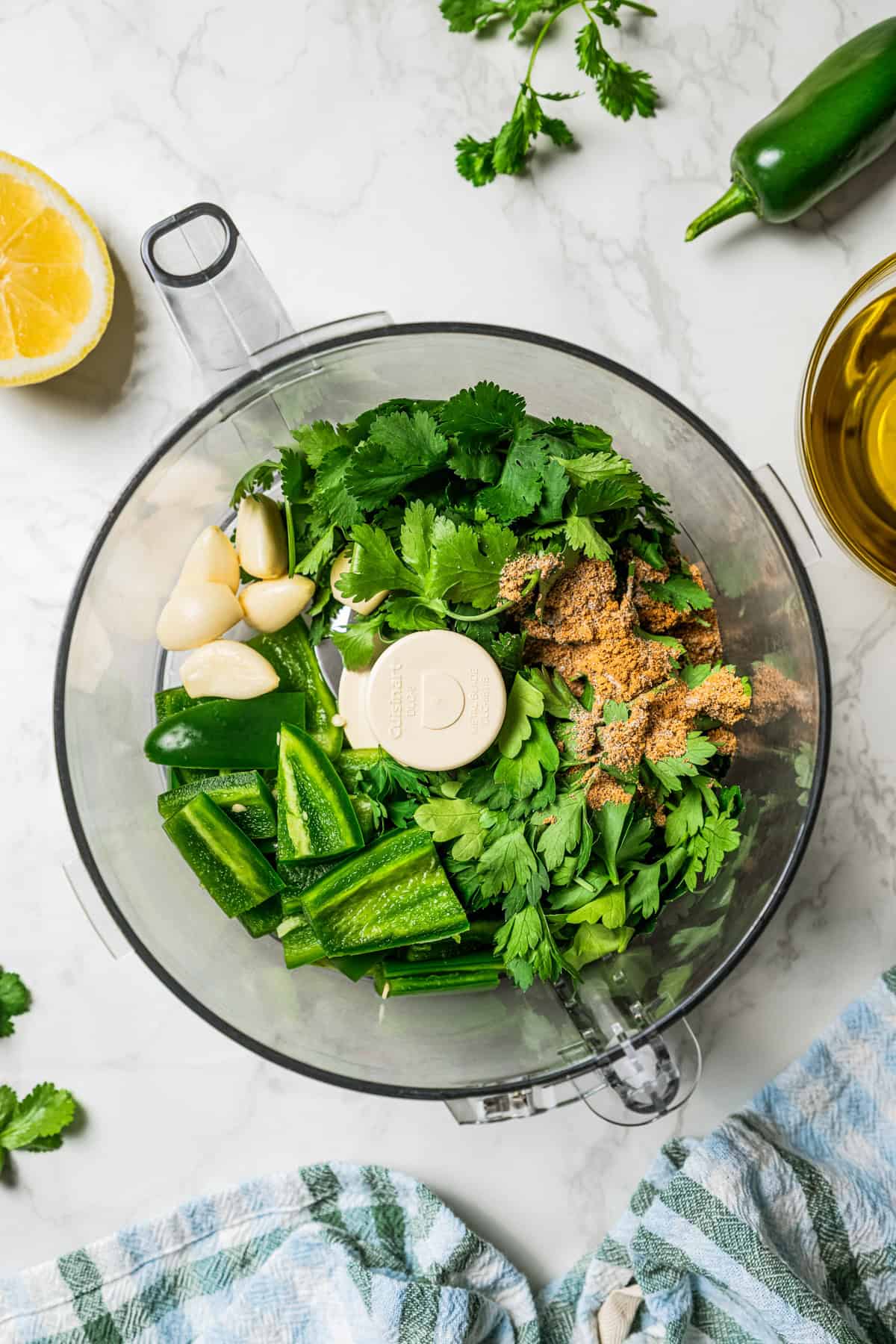Zhoug is the best way to dress up your favorite meats, veggies, and dips! Make homemade zhoug sauce with the easiest ingredients, including fresh jalapeño, cilantro, parsley, garlic, olive oil, and spices. You’ll want to put it on everything!
If you’re a fan of Peruvian green sauce, chances are good you’ll love zhoug. I use this spicy cilantro sauce to add loads of flavor to everything from salmon to chicken shawarma, and as a dressing for falafel.

We’re about to zhuzh things up with bright, flavor-packed Zhoug sauce. Zhoug, schug, or zhug, is a versatile homemade condiment, and it’s one of my must-haves in the fridge on any given day. Originating in the Middle East, Zhoug is a delicious spicy cilantro sauce made from a blend of peppers, garlic, fresh herbs, and spices. I’ll show you how to make it with a handful of ingredients in your blender!
Reasons to Make Zhoug (Spicy Cilantro Sauce)
- It’s quick and easy. All you need to make it is a few easy-to-find ingredients and your blender or food processor. It’s ready to use in minutes.
- So much flavor! There’s nothing quite like Zhoug sauce. It’s a little spicy (with the option to adapt), a little savory, with a mouthwatering mix of fresh herbs and spices. It goes well with anything and everything.
- Keep leftovers for days. Once you’ve tasted zhoug, I just know you’ll find all sorts of ways to use it, from marinating chicken to dressing roasted vegetables. Leftovers store well in the fridge or freezer, so you can make a double batch while you have the blender out.

Zhoug Sauce Ingredients
The magic of zhoug comes down to a few select fresh herbs and a handful of savory spices that give it its unique, complex flavor. I cover the ones I use to make mine below! You’ll find the full recipe with the printable amounts in the recipe card after the post, followed by step-by-step photos.
- Jalapeño – I use jalapeño peppers as they’re easy to find. You can adapt the heat level of your zhoug sauce with hotter peppers, like habanero. Deseed the peppers to tame the heat a little.
- Garlic – Fresh cloves are best here. Otherwise, substitute ½ teaspoon of garlic paste per clove.
- Fresh Herbs – Freshly chopped cilantro and parsley.
- Lemon Juice – Freshly squeezed lemon is best, but bottled lemon juice works in a pinch. You could also substitute white or red wine vinegar.
- Spices – Ground cumin, coriander, cardamom, red pepper flakes, and salt.
- Olive Oil – I recommend a good-quality olive oil as you’ll taste the difference. Avocado oil is a good substitute.
What Does It Taste Like?
Zhoug is packed with complex flavors from mildly spicy jalapeños, bright, citrusy lemon and garlic, earthy cumin, and sweet, herbal cardamom. A lot is going on, in the best possible way! It’s what makes this sauce so amazing and so versatile. Plus, if you make it at home, you can adapt the salt, spice, and other flavors to taste.

Zhoug vs. Chimichurri
Chimichurri is the Argentinian answer to Zhoug sauce. The main difference between the two green sauces is that chimichurri uses a blend of parsley, garlic, and oregano. Meanwhile, Zhoug is heavy on cilantro. You’ll find other versions, like Moroccan zhoug, that also contain mint.
Ways to Use Zhoug Sauce
Zhoug is really an all-around condiment. I like to drizzle it over dips like hummus, or stir it into Macedonian taratur (similar to tzatziki) for a spicy kick. These are just a few other easy ideas:
- Marinade. Use Zhoug sauce to marinate your favorite proteins, like chicken or beef.
- Dipping sauce. Serve this spicy green sauce alone or mixed into yogurt as a zippy dipping sauce for chicken skewers, juicy chicken bites, or salmon bites.
- Salad dressing. Add a little extra olive oil and toss your zhoug with a fresh green Mediterranean salad or use it as a dressing for tabbouleh or couscous.
- Topping. I use Zhoug sauce as a topping over salmon filets or chicken tagine, or I’ll serve it over grilled meats, like flank steak. It’s even great drizzled over my family’s favorite Macedonian fried pork pizza.
Pin this now to find it later
-
Blend the ingredients. Place everything except the olive oil in the bowl of a food processor. Pulse until everything is chopped and starting to come together.
-
Add olive oil. With the food processor running, pour the olive oil in through the top of the lid. (Through the opening where you can add liquid while the food processor is running.) Once all the olive oil has been added, turn off the food processor.
-
Scrape the bowl. Scrape down the sides and pulse a few more times until a thick sauce is formed.
-
Season to taste. Taste and adjust the seasonings if needed. You can add more salt if you want it saltier, more red pepper flakes if you want it spicier. Add these adjustments 1/4 teaspoon at a time, mixing between additions, until you achieve your desired flavor.
Calories: 87kcal | Carbohydrates: 1g | Protein: 0.4g | Fat: 9g | Saturated Fat: 1g | Polyunsaturated Fat: 1g | Monounsaturated Fat: 7g | Sodium: 199mg | Potassium: 60mg | Fiber: 0.5g | Sugar: 0.3g | Vitamin A: 589IU | Vitamin C: 14mg | Calcium: 14mg | Iron: 1mg
Nutritional info is an estimate and provided as courtesy. Values may vary according to the ingredients and tools used. Please use your preferred nutritional calculator for more detailed info.
How to Make Zhoug
Just like preparing homemade pesto sauce or blender Hollandaise, making zhoug is easy to do in your food processor:


- Blend the ingredients. Add all of your zhoug ingredients to a blender or food processor, apart from the olive oil. Pulse a few times so the mixture comes together.
- Add oil. Keep the processor running and stream in the olive oil. Once that’s added, switch off the food processor and scrape down the sides before pulsing again.
- Adjust for seasonings. Taste the sauce and adjust your seasonings to taste. I recommend adding a little at a time, mixing in between. You can always add more, but you can’t take it away! When you’re happy with your zhoug, serve it right away or store it for later, see below.
Storage Instructions
- Refrigerate. You can serve zhoug sauce immediately or keep it stored in an airtight jar or container. To help maintain its freshness, pour a thin layer of olive oil over the zhoug before you seal the lid. It lasts for 5-7 days in the fridge.
- Freeze. Yes, you can freeze zhoug! Freeze it in a freezer-safe container for up to 6 months and thaw it in the fridge when you’re ready to use it.



